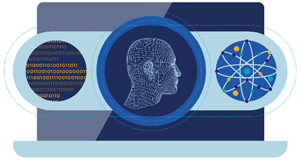Depending on what you read and who you speak with, generative artificial intelligence (Gen AI) is either a big problem or the solution to a multitude of challenges. It can be both in the case of synthetic identity fraud, as explained in a new downloadable resource of the Federal Reserve’s online Synthetic Identity Fraud Mitigation Toolkit.
 Gen AI, or deep-learning models that can create high-quality content, is now being leveraged to create realistic-seeming synthetic identities faster than ever before. Gen AI automation is being used to fraudulently apply for new accounts at a larger scale and facilitate “social engineering” scams to manipulate consumers and businesses. Proliferating synthetic identities used to commit fraud amplify the potential for increased financial losses. In fact, synthetic identity fraud – the use of a combination of personally identifiable information (PII) to fabricate a person or entity in order to commit a dishonest act for personal or financial gain – is estimated to have caused losses of $35 billion in 2023.
Gen AI, or deep-learning models that can create high-quality content, is now being leveraged to create realistic-seeming synthetic identities faster than ever before. Gen AI automation is being used to fraudulently apply for new accounts at a larger scale and facilitate “social engineering” scams to manipulate consumers and businesses. Proliferating synthetic identities used to commit fraud amplify the potential for increased financial losses. In fact, synthetic identity fraud – the use of a combination of personally identifiable information (PII) to fabricate a person or entity in order to commit a dishonest act for personal or financial gain – is estimated to have caused losses of $35 billion in 2023.
 Although criminals are using Gen AI to increase their fraudulent activities, many organizations have found positive uses for the technology to counter synthetic identity fraud. For example, AI tools and Gen AI can quickly help verify that a person is “real,” among other uses. Just as important, AI can generate fraud scenarios and data to improve model risk scores, helping financial institutions to more quickly adapt to evolving fraud patterns with less human intervention.
Although criminals are using Gen AI to increase their fraudulent activities, many organizations have found positive uses for the technology to counter synthetic identity fraud. For example, AI tools and Gen AI can quickly help verify that a person is “real,” among other uses. Just as important, AI can generate fraud scenarios and data to improve model risk scores, helping financial institutions to more quickly adapt to evolving fraud patterns with less human intervention.
Read Generative Artificial Intelligence Increases Synthetic Identity Fraud Threats (PDF) and explore the full Synthetic Identity Fraud Mitigation Toolkit for insights and downloadable resources on addressing this type of fraud.
The synthetic identity fraud mitigation toolkit was developed by the Federal Reserve to help educate the industry about synthetic identity fraud and outline potential ways to help detect and mitigate this fraud type. Insights for this toolkit were provided through interviews with industry experts, publicly available research, and team member expertise. This toolkit is not intended to result in any regulatory or reporting requirements, imply any liabilities for fraud loss, or confer any legal status, legal definitions, or legal rights or responsibilities. While use of this toolkit throughout the industry is encouraged, utilization of the toolkit is voluntary at the discretion of each individual entity. Absent written consent, this toolkit may not be used in a manner that suggests the Federal Reserve endorses a third-party product or service.
